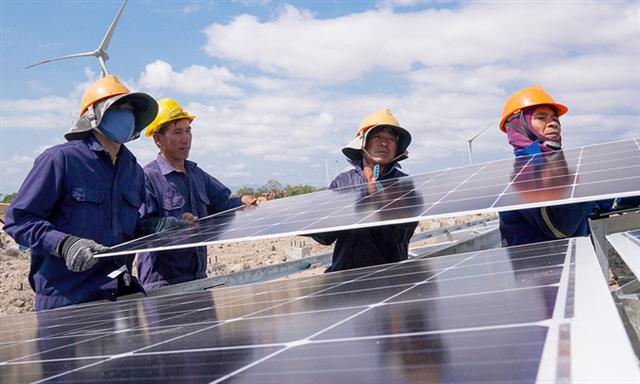Electricity oversupply forces authorities to cut solar output
Electricity oversupply forces authorities to cut solar output
After years of facing the threat of power shortages, Vietnamese authorities are concerned about an electricity glut this year, and are cutting renewable energy production.
Workers install solar power panels in Ninh Thuan Province, central Vietnam, in February 2019. Photo by VnExpress/Quynh Tran.
|
Hoa Noi Solar Power Plant in the central province of Phu Yen saw its output cut by 50 percent during the seven-day Lunar New Year (Tet) holiday in February when power demand fell as factories closed.
Solarcom Jsc, which operates a solar power plant in the central province of Binh Thuan, also saw output reduced by half during the holiday, costing the company VND200-250 million a day.
Some rooftop solar projects were forced to cut output by up to 80 percent.
Power demand during the holidays from February 10-16 dropped by 27 percent from the previous week, according to Vietnam Electricity (EVN).
At around noon, when demand is typically low, solar power production peaks, which this was why EVN had to order solar farms to cut production, energy officials said at a recent forum.
EVN chairman Duong Quang Thanh explained: "Solar power producers often tell me that if authorities keep cutting their output they will not earn enough to pay bank debts.
"For EVN, power shortages cause a headache, but oversupply makes us even more stressed."
Last year authorities resorted to cutting solar power by a total of 365 million kilowatt hours after grids in the central provinces of Ninh Thuan and Binh Thuan were overloaded.
There was a surge in renewable energy development last year, especially in the rooftop segment, which saw capacity rise 66 percent to 10,000 megawatt peak (MWp) between June and December, Nguyen Duc Ninh, director of EVN’s national load dispatch center, said.
The boom in solar power has placed enormous strain on the country’s 500-kilovolt north-south transmission line, the backbone of the national grid.
With circuits 1 and 2 of the line now running at full stretch, EVN is set to install circuit 3, but the project is still in the land acquisition stage.
With the Ministry of Industry and Trade warning that oversupply is a major threat to the country’s power security as it can damage the national grid, EVN plans to triple the renewable energy output cut to 1.3 billion kilowatt-hours this year.
The government in January ordered power authorities to reconsider proposals for solar projects and slow down the pace of development.
The chaotic management of solar rooftop, especially in December last year, caused difficulties in operating the national grid, according to a decree signed by Deputy Prime Minister Trinh Dinh Dung.
It also ordered a halt to new wind power projects.
The solar energy sector began booming in mid-2019 as the deadline for the government’s incentive feed-in tariff approached, causing developers to speed up their projects, mostly in the central and southern regions.
As a result, solar capacity surged to 19,400 MWp at the end of last year, accounting for 25 percent of total power capacity, according to EVN.
This capacity came from over 100 farms and 101,000 rooftop constructions, it said.
As Vietnam remains a rapidly growing economy with energy demand expected to rise by 8-10 percent annually until2030, the government plans to add 30,000 MW of renewable energy over the next decade.


























